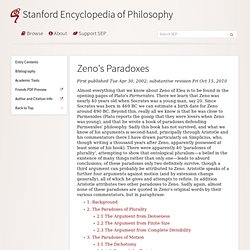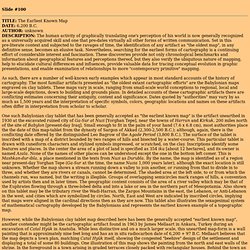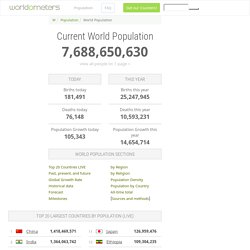

6th Century BC - Timeline Index. The Agenda of the Milesian School: The Post-Catastrophic Paradigm Shift in Ancient Greece. Thales of Miletus. Next: About this document Thales of Miletus Little is known of Thales.

He was born about 624 BC in Miletus, Asia Minor (now Turkey) and died about 546 BC in Miletos, Turkey The bust shown above is in the Capitoline Museum in Rome but is not contemporary with Thales. Google Image Result for. Anaximander Anaximander was the author of the first surviving lines of Western philosophy.

He speculated and argued about “the Boundless” as the origin of all that is. He also worked on the fields of what we now call geography and biology. Moreover, Anaximander was the first speculative astronomer. Anaximenes According to the surviving sources on his life, Anaximenes flourished in the mid 6th century B.C.E. and died about 528.

5th century bc - Timeline Index. The Eleatic school vis-a-vis rival movements. Xenophanes. First published Mon Oct 21, 2002; substantive revision Fri Feb 21, 2014 Xenophanes of Colophon was a philosophically-minded poet who lived in various parts of the ancient Greek world during the late 6th and early 5th centuries BCE He is best remembered for a novel critique of anthropomorphism in religion, a partial advance toward monotheism, and some pioneering reflections on the conditions of knowledge.

Many later writers, perhaps influenced by two brief characterizations of Xenophanes by Plato (Sophist 242c–d) and Aristotle (Metaphysics 986b18-27), identified him as the founder of Eleatic philosophy (the view that, despite appearances, what there is is a changeless, motionless, and eternal ‘One’). In fact, the Xenophanes who emerges from the surviving fragments defies simple classification. Xenophanes of Colophon. Parmenides. First published Fri Feb 8, 2008; substantive revision Sun Jun 3, 2012 Parmenides of Elea, active in the earlier part of the 5th c.

BCE, authored a difficult metaphysical poem that has earned him a reputation as early Greek philosophy's most profound and challenging thinker. His philosophical stance has typically been understood as at once extremely paradoxical and yet crucial for the broader development of Greek natural philosophy and metaphysics. He has been seen as a metaphysical monist (of one stripe or another) who so challenged the naïve cosmological theories of his predecessors that his major successors among the Presocratics were all driven to develop more sophisticated physical theories in response to his arguments. Zeno's Paradoxes. First published Tue Apr 30, 2002; substantive revision Fri Oct 15, 2010 Almost everything that we know about Zeno of Elea is to be found in the opening pages of Plato's Parmenides.

There we learn that Zeno was nearly 40 years old when Socrates was a young man, say 20. Since Socrates was born in 469 BC we can estimate a birth date for Zeno around 490 BC. Beyond this, really all we know is that he was close to Parmenides (Plato reports the gossip that they were lovers when Zeno was young), and that he wrote a book of paradoxes defending Parmenides' philosophy. Sadly this book has not survived, and what we know of his arguments is second-hand, principally through Aristotle and his commentators (here I have drawn particularly on Simplicius, who, though writing a thousand years after Zeno, apparently possessed at least some of his book). Melissus of Samos, a Brief Outline of His Eleactic Philosophy. 600 B.C.E. In the Sixth Century B.C.E.

(beginning some 600 years before the current era), something absolutely extraordinary happened. Prior to this time, religion for mankind was essentially based on doing what the Gods and Goddesses (aka, the “Anunnaki”) wanted man to do. If a god (or goddess) wanted you to go to war, you went to war. 6th Century B.C. Timeline - Archaic Greek and Legendary Roman Timeline for the 6th century B.C. Timeline of Greek and Roman Philosophers. Philosophy: By Movement / School > Ancient > Pluralism. Ancient Map Web List. Slide #100 Monograph. Slide #100 TITLE: The Earliest Known MapDATE: 6,200 B.C.AUTHOR: unknownDESCRIPTION: The human activity of graphically translating one's perception of his world is now generally recognized as a universally acquired skill and one that pre-dates virtually all other forms of written communication.

Set in this pre-literate context and subjected to the ravages of time, the identification of any artifact as "the oldest map", in any definitive sense, becomes an elusive task. Nevertheless, searching for the earliest forms of cartography is a continuing effort of considerable interest and fascination. These discoveries provide not only chronological benchmarks and information about geographical features and perceptions thereof, but they also verify the ubiquitous nature of mapping, help to elucidate cultural differences and influences, provide valuable data for tracing conceptual evolution in graphic presentations, and enable examination of relationships to more "contemporary primitive" mapping.
100A Town Plan from Catal Hyük (6200 B.C.)
Getting started. World Population Clock: 7 Billion People. World Population: Past, Present, and Future (move and expand the bar at the bottom of the chart to navigate through time) The chart above illustrates how world population has changed throughout history.

View the full tabulated data.